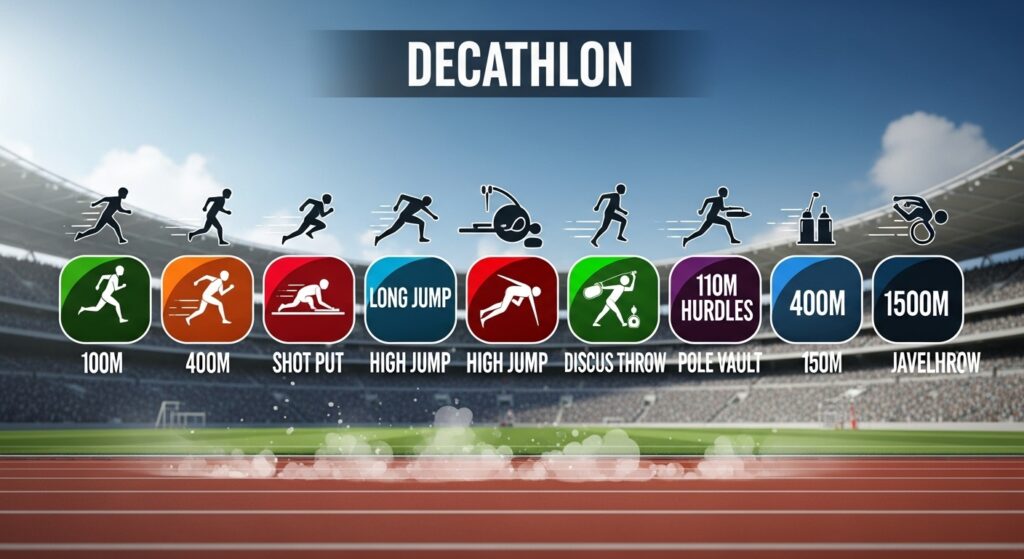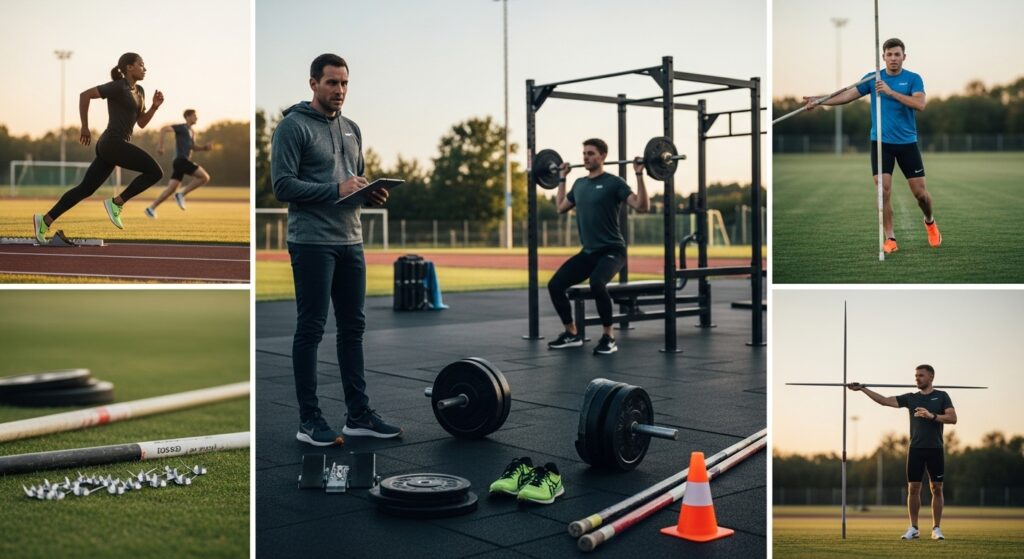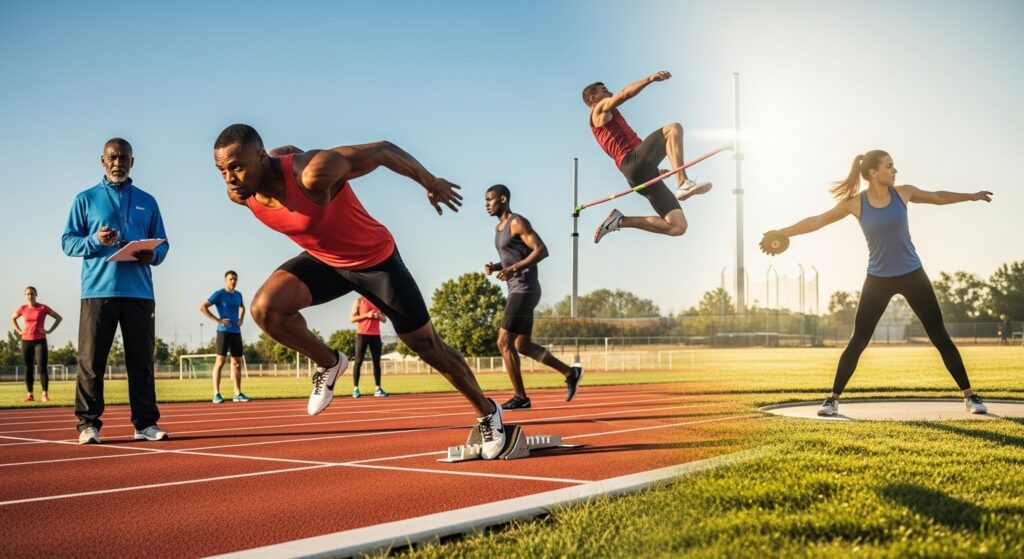As a coach and former decathlete who has lived on track ovals for 12+ years, here’s the quick take: decathlon events are ten track and field challenges over two sweaty days. Sprinting, jumping, throwing, and trying not to pull a hamstring. It’s a combined events circus, and yes, it’s fun. Also brutal. I love it.
What it is, in plain words

Ten events. Two days. You score points in each, based on time or distance. Add them up. Highest total wins. That’s the whole plot. No judges’ drama, no secret sauce—just math and grit. If you want the clean textbook version, this page lays it out well: Decathlon basics and event order. Me? I’ll give you the stuff people don’t say out loud.
The order and why it matters
- Day 1: 100m, long jump, shot put, high jump, 400m
- Day 2: 110m hurdles, discus, pole vault, javelin, 1500m
Day 1 is speed and pop. Day 2 is technique and patience. And the 1500m is the tax you pay for wanting to be called the “best all-around.” In my experience, the mental dip after the 400m is real. Day 2 requires a fresh brain. And snacks. Many snacks.
What scores actually mean
I’ve always found people get lost in points. Here’s the short version. Every event has a formula. Run faster, throw farther—points go up. A decent long jump for a strong decathlete is around 7.20 m. A strong 100m might be in the low 10.7s. Pole vault at 5.00 m? Chef’s kiss. If you’re curious about the nerd-level rules, World Athletics decathlon rules are the source I point to when arguments break out at meets.
Quick cheat sheet I tell my athletes
- Speed points are “cheap.” Work your 100m, hurdles, and 400m.
- Technical events have ceilings. Fix your pole vault and discus form early.
- Don’t chase hero throws if your back hates you. Live to score in the next event.
- The 1500m is a timed survival. Negative split and don’t sprint the first 200.
How I prep athletes for ten different things without losing my mind
What I think is simple: you can’t be perfect at all ten. You aim for “very good” across the board. We build a base of sprint mechanics, basic plyometrics, and simple barbell lifts. Then we rotate technical days—vault and javelin don’t like to share, trust me. When gear or rule changes show up, I skim the latest sports trends to see what the rest of the field is trying (carbon plates in spikes, lighter poles, weird tape jobs—you know the vibe).

Famous names and why they matter
I still watch Ashton Eaton’s splits and Kevin Mayer’s throws when I teach. Technique leaves clues. New athletes learn faster by seeing clean lines and good rhythm. If you’re into the human side and like reading about the grind, I love browsing athlete spotlights to keep folks inspired without turning practice into a TED Talk.
Training blocks that actually work
In my experience, three simple blocks beat fancy periodization charts you’ll forget to follow.
- Foundation block: easy tempos, general strength, drills, and light throws. Focus on movement quality.
- Technique block: vault reps, discus and javelin mechanics, hurdle rhythm, high-jump approach timing.
- Competition prep: short, sharp work. Clean takeoffs, fast 120s, a few heavy shot put throws, and controlled vault bars.
I cycle these, with mini-peaks before meets. Nothing epic. Just consistent. Rest is a training method too. I am saying this to you, and to past me who thought two-a-days after pole vault was “fine.” It was not.
Day-of-meet logistics (the unglamorous truth)
- Pack extra spikes, extra socks, and extra patience.
- Eat like a hummingbird: small, often. Bananas, rice cakes, yogurt. Not chili fries. Never again.
- Warm up short. Keep the powder dry for attempts that count.
- Hydrate before you’re thirsty. Also, sunscreen. You’re welcome.
Event-by-event snapshots
People love a neat list, so here’s the run-through I give parents who ask, “Which one is the one with the stick?” That would be javelin. Or pole vault. Depends which stick.
100m and long jump
These set the tone. If the 100m is clean, the day opens up. Long jump is about speed you can use and a board you can actually hit. Overrun the board and you gift-wrap points for your rivals. I’ve seen athletes win meets just by being boringly consistent here.
Shot put and high jump
Shot put: learn a simple glide before you chase a full spin. High jump: posture and patience. Don’t rush the curve. If you sprint at the bar like it owes you money, the bar will win.
400m
The 400m is where day 1 dreams go to cramp. My advice: even first 200, lift the knees down the backstretch, and hold your form when your brain starts writing sad songs. If you want current meet chatter and context across sports, I often peek at multi-sport news to keep perspective on how other athletes manage pacing and recovery.
110m hurdles
Day 2 starts with rhythm and terror. Keep the hips up, run through the hurdle, and don’t overstride to “save” a bad step—you’ll just create two new problems. A smooth 15-step pattern early can be worth more than a sketchy 14.
Discus and pole vault
Discus is a dance. Relax the shoulders and let the hips lead. Pole vault is chess. Change one thing at a time—pole, grip, or step—never all three. If you want a clean overview for newcomers, this mainstream explainer is solid: Olympics decathlon primer. Simple and useful.
Javelin and 1500m
Javelin rewards patience more than power. Keep the left side firm, hit the block, and send it. The 1500m? I set three pace checks: 300m relaxed, 900m hold, 1200m go. No hero first lap. If you’re more into the drama and big moments, I save clips and notes from match highlights to show younger athletes how races actually unfold when it matters.
Scoring targets I give to developing decathletes
In my experience, beginners need simple numbers to chase. Here’s the fast reference I stick on a locker. These are rough “solid for high school/college dev” marks I’ve used as checkpoints. Hit most of them and you’ll see a nice score bump.
- 100m: around 11.3 s
- Long jump: around 6.60 m
- Shot put: around 12.50 m
- High jump: around 1.90 m
- 400m: around 51.0 s
- 110mh: around 15.8 s
- Discus: around 38.0 m
- Pole vault: around 4.40 m
- Javelin: around 50.0 m
- 1500m: around 4:45
Not perfect. But realistic. If you’re nerding out on comparisons to heptathlon or want to cross-check history, this write-up is good weekend reading: Britannica’s decathlon overview.
Mini-blogs inside the blog (because attention spans)

Which event gives the most “bang for your buck” to train?
Honestly, hurdles. Fixing three things there can add 100+ points fast. After that, long jump board accuracy. And if your pole vault is a mess, even a 20 cm PR is a feast of points.
What specs do you actually need for shoes and poles?
Simple: comfy spikes you can wear all day, not just for one event. I rotate a mid-distance spike for the 400/1500 and a long jump spike for both LJ and TJ (when we mix meets). Pole wise, don’t jump on a hero stick. Build on a pole you can move, then size up once the takeoff is honest. When I spot a new gear fad, I filter it through sports trends to keep my wallet from doing dumb things.
How do you stay sane across ten events?
Routines. Tiny ones. Same warm-up song. Same pre-jump breath. Same snack after throws. Save your brain for the bar and the board. The rest? Put it on autopilot.
If you want to watch and learn fast
I point newcomers to meet recaps and short clips. You’ll learn more from one clean plant in pole vault than from five pages of jargon. For feel-good and fail-forward stories that actually teach, I like curated athlete spotlights because they show the ugly reps, not just the medals.
Fantasy, picks, and friendly bets (for the numbers people)
Okay, I’m only half-joking, but decathlon actually works for props and fantasy-style scoring at local meets. Weight early speed and vault consistency. Discount javelin unless you see a clean block and a no-rain forecast. If you dabble, some fantasy tips translate: look for “safe floor” athletes who don’t zero in technical events.
My short list of do’s and don’ts
- Do learn hurdle rhythm before you chase top speed.
- Do keep a training log. Points love patterns.
- Don’t change poles and grips on the same day unless you enjoy chaos.
- Don’t run the first 200 of the 400 like it’s the last 50 of your life.
- Do practice safe throw sector habits. Officials are not moving targets.
How I watch a meet like a scout

I stand near the board for long jump and the box for vault. I check approach marks, check if they can hit the same spot twice. Then I look at discus footwork—are they balanced over the left? Finally, I time the last 300 of the 1500m. If they can push there, they trained right. I’ll usually compare notes with what’s trending across sports in multi-sport news to see if conditioning patterns line up.
Why I still love this crazy thing
I’ve coached kids who could barely get over a hurdle in week one, then PR’d in seven events by the end of the season. I’ve bombed a javelin so badly I had to pretend I meant to throw it short for “technique reasons.” And yet, the whole puzzle keeps pulling me back. Say what you want, but there’s nothing like packing up after the 1500m, sticky with sports drink, knowing you fought all ten. Anyway. I’ve got tape to re-roll and a pole bag to argue with. You know how it goes.
FAQs
How many events are in the decathlon, and over how many days?Ten events over two days. Five each day. Points from each are added for a total.
What’s the hardest event to learn first?Pole vault. It’s technique on top of fear management. Start slow and keep changes simple.
Can I train for decathlon events without a fancy facility?Yes. Sprint mechanics on grass, med-ball throws for patterns, and simple hurdles with cones. Do what you can, cleanly.
How do points work—do I need to memorize formulas?No. Use a points calculator and aim for steady PRs. Faster and farther equals more points. That’s the gist.
Is the 1500m really that bad?It’s not bad. It’s honest. Pace it right, and it’s a solid finish. Go out too hot, and the last lap writes your memoir.

I’m Oliver Scott, and I live to bring every sports moment to life. Get breaking multi-sport news, in-depth match highlights, fantasy tips, athlete spotlights, and the latest trends right here.



